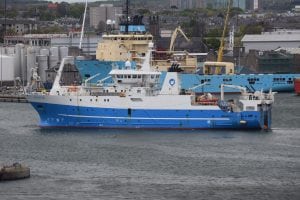Marine
The Scotia went to CTD to see what she could ADCP
September 25, 2017 by Marine Scotland Communications No Comments | Category Marine Directorate general, Marine Directorate Science, Marine Directorate Surveys, Research Vessel Surveys
Gear
Sea-Bird CTDs (Conductivity, Pressure & Depth), ADCP (Acoustic Doppler Current Profiler) instrumentation and AL-200 frame, water filtering equipment, bacteria sampling and experimental equipment, including bacterial culture equipment with CO2 gas enrichment (HWU), mooring equipment and recovery trawl.
Objectives
- Test the CTD in the Buchan Deep off Peterhead
- Perform hydrographic sampling along the JONSIS long term monitoring section in the northern North Sea.
- Deploy ADCP on JONSIS line in AL-200 frame (AECO).
- Recover and download the data from a single string ACDP mooring on the Fair Isle – Munken section in the FSC (NWS-E).
- Re-deploy one ADCP mooring at a position on Fair Isle – Munken section.
- Take surface water samples near FIM 8 location for phytoplankton and bacterial analysis and experimentation (HWU).
- Perform hydrographic sampling along the long term monitoring Faroe-Shetland Channel Nolso – Flugga (NOL/NWE) section.
- Perform hydrographic sampling along the long term monitoring Faroe-Shetland Channel Fair Isle – Munken (NWS) section.
- Take water samples for long term storage on two Fair Isle – Munken or Nolso – Flugga section stations.
- Take water samples for bacteria analysis at selected stations on the monitoring lines.
- Recover one ADCP mooring at a position on Faroe-Shetland Channel Faroe – Cape Wrath (FCW/NWZ) section (NWZ-E).
- Perform hydrographic sampling in the vicinity of the above ADCP mooring in order to calibrate the mooring equipment.
- Perform a CTD transect along a Stonehaven AlterEco section (going west from 2° E).
Procedure
On sailing, Scotia will carry out test deployments of the CTD and carousel around the Buchan Deep, using the standard deployment procedures (10 m soak); sampling procedures will also be rehearsed at the test station. Scotia will then make passage to the start of the JONSIS long term monitoring section to carry out sampling with the CTD and carousel water sampler. On completion of the JONSIS section, passage will be made to the mooring location on the JONSIS line, where the ADCP in the AL-200 will be deployed.
On completion, passage will be made to the ADCP mooring site on the Fair Isle – Munken (FIM) section, where the ADCP mooring will be recovered and a CTD profile performed. Scotia will then stay on site while the data is downloaded and the mooring refurbished for re-deployment. Scotia will then make her way to FIM-08 for water sampling for phytoplankton and bacteria (time permitting) before sailing to the western end of the Nolso – Flugga (NOL) section.
Water samples and CTD profiles will be taken along the NOL section. Scotia will then proceed to the FIM section to carry out standard CTD and water sampling along that line. Along the standard sections water samples will be taken at a subset of stations for bacterial work by HWU visitors. After the FIM section Scotia will sail to the mooring location on the Faroe – Cape Wrath (FCW) line (NWZE) where the mooring will be recovered and CTD profile performed. Scotia will then make her way to the eastern end of the Stonehaven CTD line and make her way back west along the line performing CTD profiles.
Further Information
Tags: Monitoring, plankton, sampling, science



Leave a comment